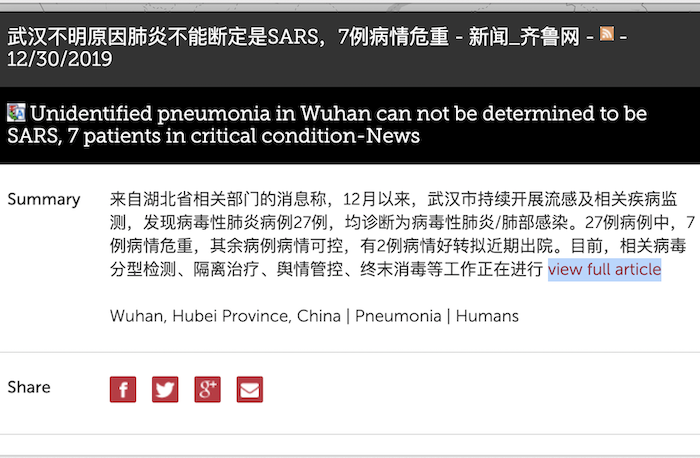By: Kara Sewalk
Image courtesy of Chris Blakely via Flickr Creative Commons
On 5 January 2020, the World Health Organization (WHO) announced a cluster of pneumonia cases of unknown etiology in Wuhan City, Hubei Province of China [1]. By 9 January 2020, WHO released a statement regarding the determination that a novel coronavirus (nCoV-2019) was identified as the causative agent of the case clusters [2]. As of 31 January 2020, nearly 10,000 confirmed cases and over 200 deaths have been observed globally, with a vast majority in China [3]. Cases have also been confirmed in: Australia, Cambodia, Canada, France, Finland, Germany, India, Italy, Hong Kong, Japan, Macau, Malaysia, Nepal, Philippines, Russia, Singapore, Sri Lanka, South Korea, Sweden, Taiwan, Thailand, Vietnam, United Arab Emirates, United Kingdom and the United States [4].
On 30 December 2019, the global disease monitoring system ProMED captured information on unexplained pneumonia cases [5] in Wuhan with information on isolation test results to follow. This data was obtained through social media (Weibo) channels. Simultaneously on 30 December, the infectious disease surveillance system HealthMap collected a media alert regarding an unidentified respiratory illness outbreak in Wuhan, with 27 suspected cases reported at that time [6]. Both systems provided early warning signals for the nCoV-2019 outbreak, and continue to monitor the spread of disease.
The Program for Monitoring Emerging Disease (ProMED), of the International Society for Infectious Diseases (ISID), was launched in 1994, the system is designed to identify unusual health events related to emerging and re-emerging infectious diseases [7]. HealthMap, founded in 2006 at Boston Children’s Hospital, uses automated technologies to capture and aggregate real-time online news media alerts to track infectious diseases globally [8]. Systems such as ProMED and HealthMap are designed to detect early signals of disease threats, to better inform public health officials and provide real-time updates on disease outbreaks.
Both ProMED and HealthMap are contributing data sources to the WHO-led Epidemic Intelligence from Open Sources (EIOS) Initiative. EIOS aims to bring together existing initiatives, networks and systems to create a unified approach to early detection, verification and assessment of public health risks [9]. Insights from event-based surveillance using these technologies provide participating health and governmental organizations early signals on global health threats, and has been used for response efforts for H1N1 in 2009 [10], Ebola in 2014 [2], and Zika in 2015[3].
ProMED and HealthMap provide open source, up-to-date monitoring of the current nCoV-2019 outbreak for public health professionals and the public alike. For more information on the status of the outbreak, please visit https://promedmail.org/ and https://healthmap.org/.
In partnership with colleagues at Oxford University, Northeastern University and Tsinghua University, the HealthMap team has mapped the ongoing case counts from the nCoV-2019 outbreak: https://www.healthmap.org/ncov2019/
References
[1] https://www.who.int/csr/don/05-january-2020-pneumonia-of-unkown-cause-china/en/
[3] https://www.nytimes.com/2020/01/27/world/asia/china-coronavirus.html
[4] https://www.cdc.gov/coronavirus/2019-ncov/locations-confirmed-cases.html
[5] https://promedmail.org/promed-post/?id=6864153
[6] http://news.iqilu.com/china/gedi/2019/1231/4407838.shtml
[10] Brownstein JS, Freifeld CC, Chan EH, et al. Information technology and global surveillance of cases of 2009 H1N1 influenza. N Engl J Med. 2010;362(18):1731–1735. doi:10.1056/NEJMsr1002707
[11] https://www.politico.com/story/2014/08/healthmap-ebola-outbreak-109881


